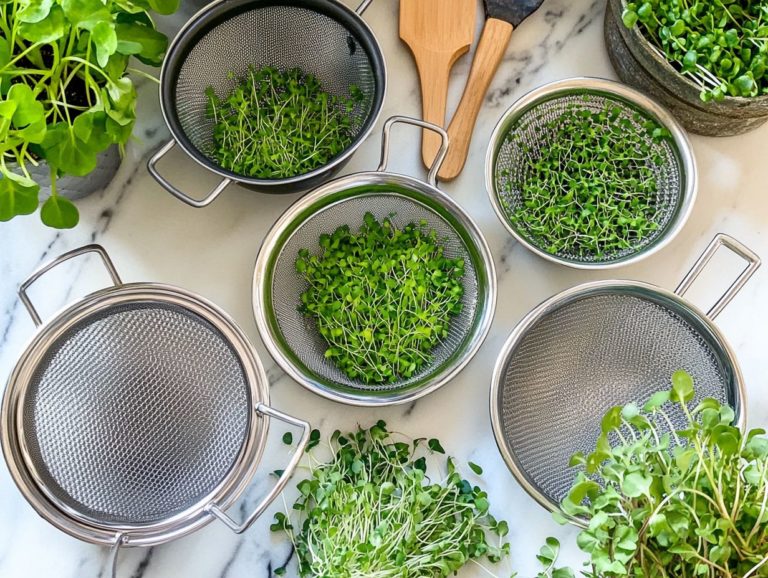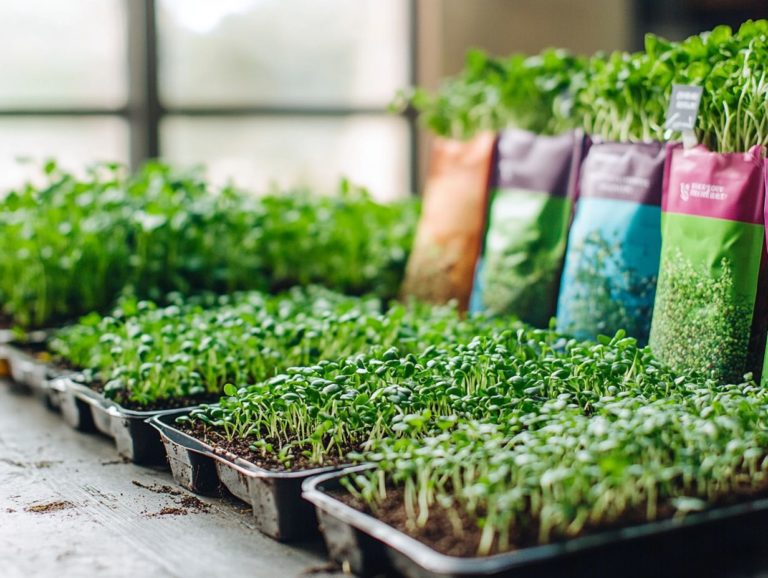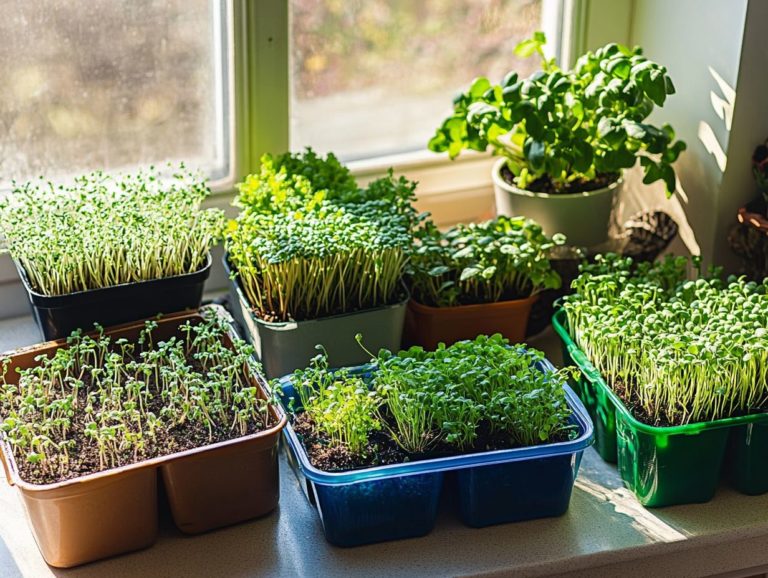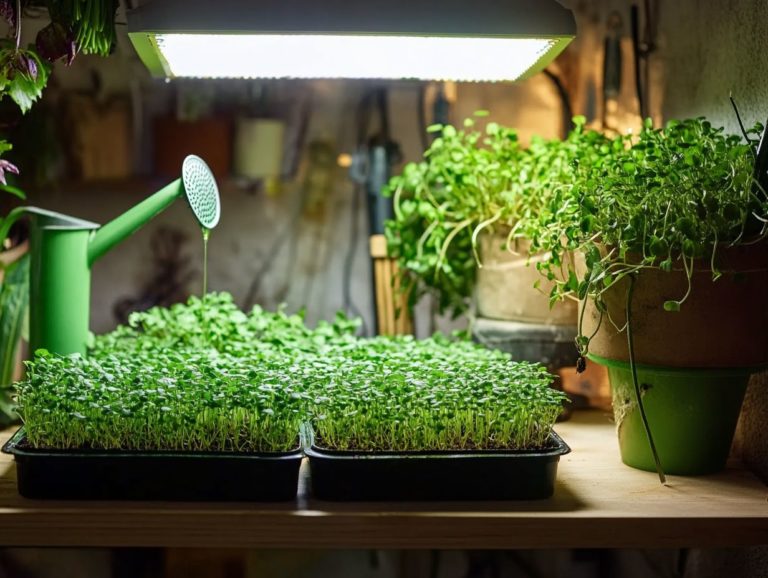Understanding Microgreen Growing Supplies
Microgreens are tiny, nutrient-dense plants that have surged in popularity within the culinary scene. They bring a burst of vibrant flavor and color to your dishes. The best part? Growing them at home is both surprisingly simple and immensely rewarding.
This article delves into the myriad benefits of cultivating microgreens. It highlights their remarkable nutritional profile and unmatched convenience. You’ll learn about the essential supplies you’ll need, how to select the perfect varieties, and detailed, step-by-step instructions for planting, nurturing, and harvesting these miniature greens.
Whether you’re an experienced gardener or just starting out, you ll discover how to seamlessly integrate microgreens into your home garden and elevate your culinary creations.
Contents
Key Takeaways:

- Microgreens are young, nutrient-dense plants that are easy to grow at home.
- You’ll need quality microgreen seeds, soil, containers, and proper light and water.
- Choose microgreen varieties based on taste, growing time, and yield.
What are Microgreens?
Microgreens are young, edible plants harvested just after sprouting, typically within 7 to 21 days. They ve become a favorite among urban gardeners and home gardening enthusiasts. These petite greens deliver an impressive nutritional punch, offering vitamins, minerals, and antioxidants often found in higher concentrations than in their mature counterparts.
Their allure lies in their vibrant colors and diverse flavors. They are easy to cultivate, with common varieties like arugula, radish, basil, and broccoli, each showcasing unique characteristics and growth needs.
These miniature plants thrive in various growing conditions. They require minimal space and resources, making them perfect for container gardening or small indoor setups. To truly optimize your microgreen experience, it’s essential to understand their growth cycles. Microgreens can effortlessly elevate your culinary creations, enhancing both their visual appeal and flavor.
Incorporating these nutrient-dense greens into your meals may help improve your health, aid digestion, and boost your immune function, all while promoting a more balanced and wholesome diet.
Benefits of Growing Microgreens
Growing microgreens presents you with a wealth of advantages. They enrich your home gardening experience while playing a vital role in sustainable food production. These nutrient-packed greens are remarkably easy to cultivate in diverse settings, including your kitchen windowsill. They deliver a swift return on investment in both health benefits and culinary delight.
Nutritional Value and Convenience
Microgreens are a powerhouse of nutrients, often packing more vitamins and minerals than their fully grown counterparts. This makes them a prized addition to your diet. Imagine the joy of harvesting your own fresh microgreens right from your kitchen!
These miniature wonders come in delightful varieties, such as radish, kale, and arugula, and are loaded with essential nutrients like vitamin C, vitamin K, and a wealth of antioxidants. For example, while mature kale is beneficial, its microgreen version can contain up to 40 times more nutrients per pound. This remarkable concentration elevates your meals while supporting your overall health.
Growing microgreens requires minimal resources, making them an excellent choice for those living in compact spaces. This accessibility fosters healthier eating habits and transforms gardening into a rewarding hobby, especially when you explore using natural fertilizers for microgreen growth, allowing you to bring a touch of nature right into your home.
Essential Supplies for Growing Microgreens
To successfully cultivate microgreens, gather a few essential supplies: high-quality microgreen seeds, sturdy growing trays, and a suitable growing medium, such as rich soil or hydroponic media (which means growing plants without soil, using nutrient-rich water instead).
Familiarizing yourself with the optimal conditions like maintaining the right soil moisture levels and nutrient solutions is key to ensuring your microgreens flourish beautifully. Understanding microgreen seed germination will further enhance your success.
Seeds and Soil
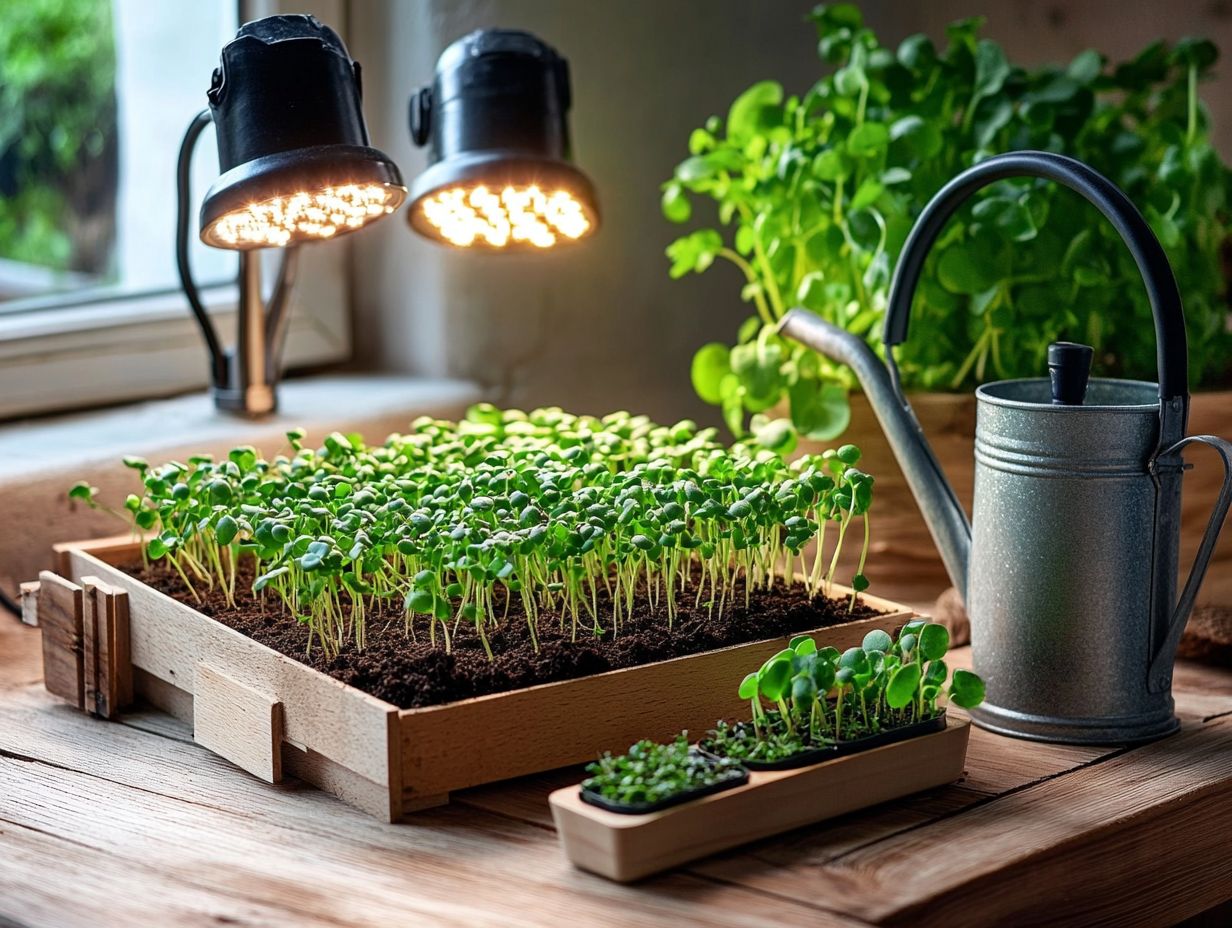
Choosing the right microgreen seeds and suitable soil or hydroponic media is essential for achieving best seed growth and development. A quality seed starting mix or organic matter provides the nutrients needed for healthy microgreen growth.
As you explore various microgreen seeds, you’ll find a wide range from the peppery notes of arugula to the delicate essence of pea shoots. Each option brings unique flavors and textures to your plate. Your choices should reflect your taste preferences as well as the nutritional benefits they offer. For instance, basil and sunflower microgreens are known for their rich antioxidant profiles. To better understand how these plants thrive, consider learning about understanding microgreen growth cycles.
The growing medium is also very important, as the right soil or hydroponic setup can greatly enhance water retention and air circulation in the process of allowing air to reach the roots. By focusing on these key factors and considering understanding microgreen post-harvest care, you can cultivate a vibrant and nutritious microgreen garden tailored to your culinary and health aspirations.
Growing Containers
The choice of growing containers can significantly influence the success of your microgreens project. Options range from compact 5×5 trays to spacious 10×20 trays made from food-safe plastic. By selecting containers with appropriate drainage and depth, you ll set up the perfect environment for your seedlings.
Different types of growing containers offer unique advantages, catering to your specific needs and ensuring healthy, vibrant crops. For example, biodegradable options provide an eco-friendly alternative, allowing for easy transplanting without disturbing the roots.
Mesh-bottom trays improve drainage, preventing waterlogging and promoting proper airflow around those delicate root systems. If you prefer efficiency, using individual cell packs can streamline your harvesting process while preserving the integrity of each microgreen. To enhance your growing techniques, consider understanding microgreen growth rates for better results.
When it comes to container materials, always choose non-toxic, safe plastics or materials that won t leach harmful substances. This way, you ll create a thriving environment for your nutritious greens to flourish.
Lighting and Watering Systems
Providing the right light source and an effective watering system is crucial for growing microgreens, as these elements significantly influence moisture levels and nutrient availability. Ensure proper light exposure whether through natural sunlight or artificial lighting along with regular watering using a spray bottle or watering can to foster healthy growth.
Aim for your microgreens to receive about 12 to 16 hours of light each day for optimal development. If you’re using artificial light, LED grow lights are an excellent choice; they provide the necessary spectrum for photosynthesis while minimizing heat. To ensure the freshest microgreens, it’s also important to understand their shelf life. For more details, check out understanding microgreen shelf life.
Maintaining moisture levels is equally crucial; overwatering can lead to rot, while underwatering will stunt growth. Regularly check the soil for dampness and use a fine mist spray to achieve the right moisture balance.
By incorporating these practices into your routine, you can effortlessly cultivate vibrant, nutrient-dense microgreens.
Choosing the Right Microgreen Varieties
Selecting the right microgreen varieties is essential for enhancing both flavor and health benefits. Each type of microgreen has its own distinct taste profile and nutritional value.
Explore the peppery notes of arugula or the subtle sweetness of different lettuce types. Each choice offers unique flavors and health benefits, reflecting your culinary preferences and the health advantages you’re after.
Don t wait start your microgreen garden today to enjoy fresh flavors and health benefits!
Factors to Consider
When choosing microgreen varieties, you should consider several factors, such as growing conditions, nutrient balance, and flavor profiles. This ensures a successful harvest that meets both your health and culinary needs.
Local gardening trends can significantly influence your choices, as certain varieties may thrive better in specific environments. Understanding the climate of your region is crucial; for instance, if you’re in a warmer area, heat-loving varieties may be your best bet. Conversely, cooler climates might call for hardier selections.
Assessing your preferred flavors can lead to delightful culinary experiments. Whether you’re drawn to the spicy kick of radish microgreens or the mild sweetness of pea shoots, engaging with local gardening communities can provide you with invaluable insights into successful varieties, planting techniques, and potential pest challenges.
By harmonizing these considerations, you can curate a collection of microgreens that truly flourish, enhancing both your health and culinary adventures.
Steps for Growing Microgreens
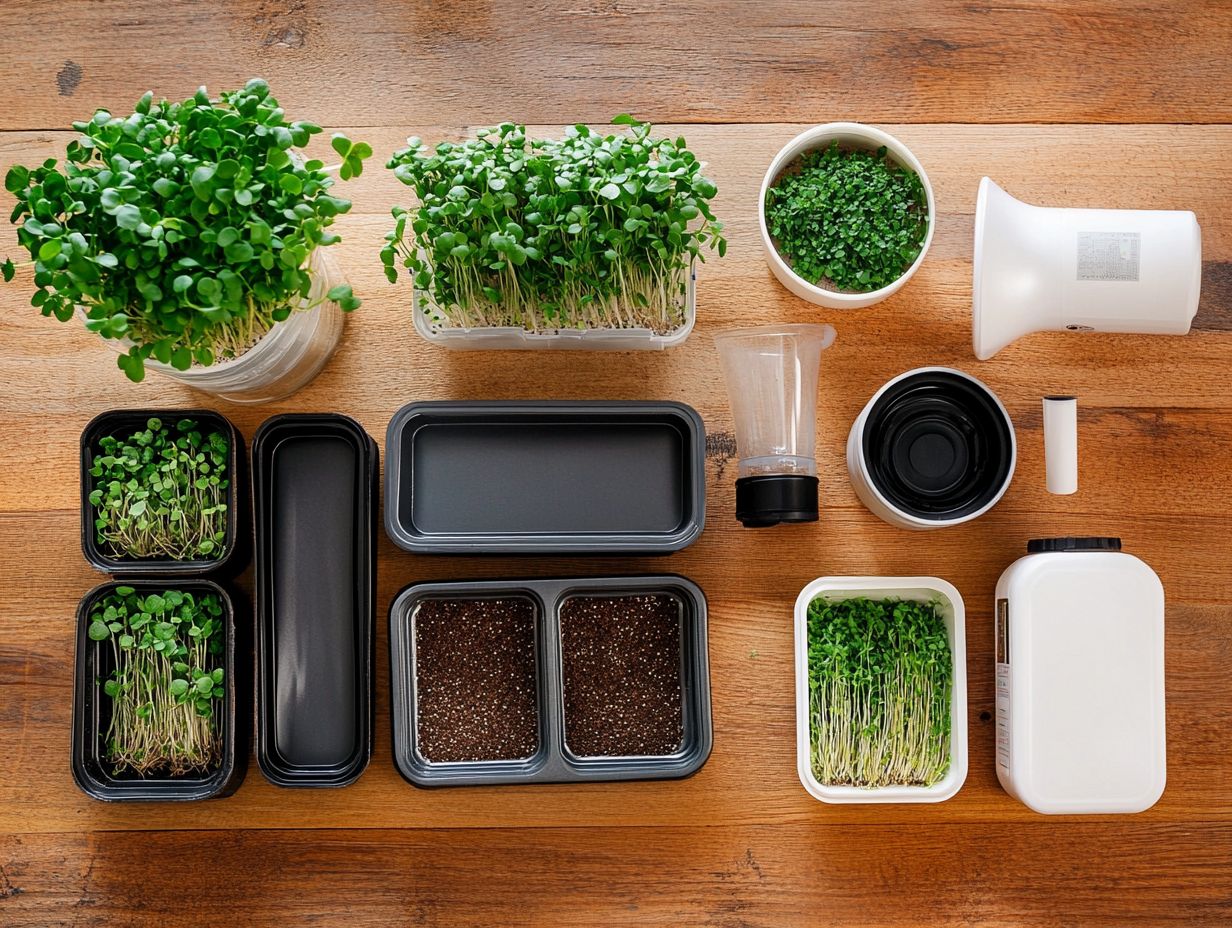
Growing microgreens requires a series of basic steps that you ll want to master. It all begins with seed germination, followed by maintaining the optimal moisture level and achieving the ideal pH balance the level of acidity or alkalinity in the soil.
By meticulously managing these factors, you can cultivate vibrant, nutrient-dense greens in the comfort of your own home garden.
Planting and Caring for Microgreens
Planting microgreens requires you to sow seeds in suitable planting trays, ensuring optimal soil moisture, and using a blackout dome during the germination phase. Using trays designed for sprouting can boost your harvest.
With careful management of watering trays and nutrient solutions, you’ll sustain healthy growth throughout the entire process.
- First, you need to select high-quality seeds that are perfect for microgreens think radishes to basil.
- Once you’ve laid the seeds evenly on pre-moistened soil, a light covering can facilitate even germination.
Consistent soil moisture is crucial; too much or too little can hinder growth. A spray bottle for gentle misting is often your best friend here. By introducing watering trays, you can water efficiently, promoting drainage while steering clear of waterlogging. To better understand how to optimize your microgreen cultivation, check out this guide on microgreen growth phases.
Regularly checking for dryness and adjusting your watering frequency will keep your microgreens thriving. This ultimately leads to a nutritious harvest that bursts with flavor and color.
Harvesting and Using Microgreens
Harvesting microgreens at the perfect moment is essential for maximizing both flavor and nutritional value. This enables you to relish these vibrant greens across a range of culinary applications.
Use effective storage techniques to keep them fresh, making them an invaluable asset to your food production endeavors.
Best Practices for Harvesting and Storage
Discover how to get the most flavor and nutrition from your microgreens by following these best practices for harvesting and storage. Utilizing food-safe plastic containers for storage will help keep your greens fresh for longer, while composting any leftover greens supports sustainability.
Timing is critical in the harvesting process; you should aim to collect microgreens just after their first true leaves appear, typically between 7 to 21 days post-germination, depending on the variety. Utilizing sprouting trays for microgreens can enhance your growing experience. Sharp scissors are your best friend here, allowing for a clean cut just above the soil level. This not only prevents contamination but also encourages healthy regrowth if that’s on your agenda.
Employing proper storage techniques, such as keeping your harvested microgreens in a cool, dark place, can significantly prolong their shelf life. By embracing these practices, you can fully savor the robust flavors and nutritional benefits that these vibrant shoots have to offer.
Frequently Asked Questions
Have questions? Start your microgreen journey today!
What are microgreens and why are they popular?
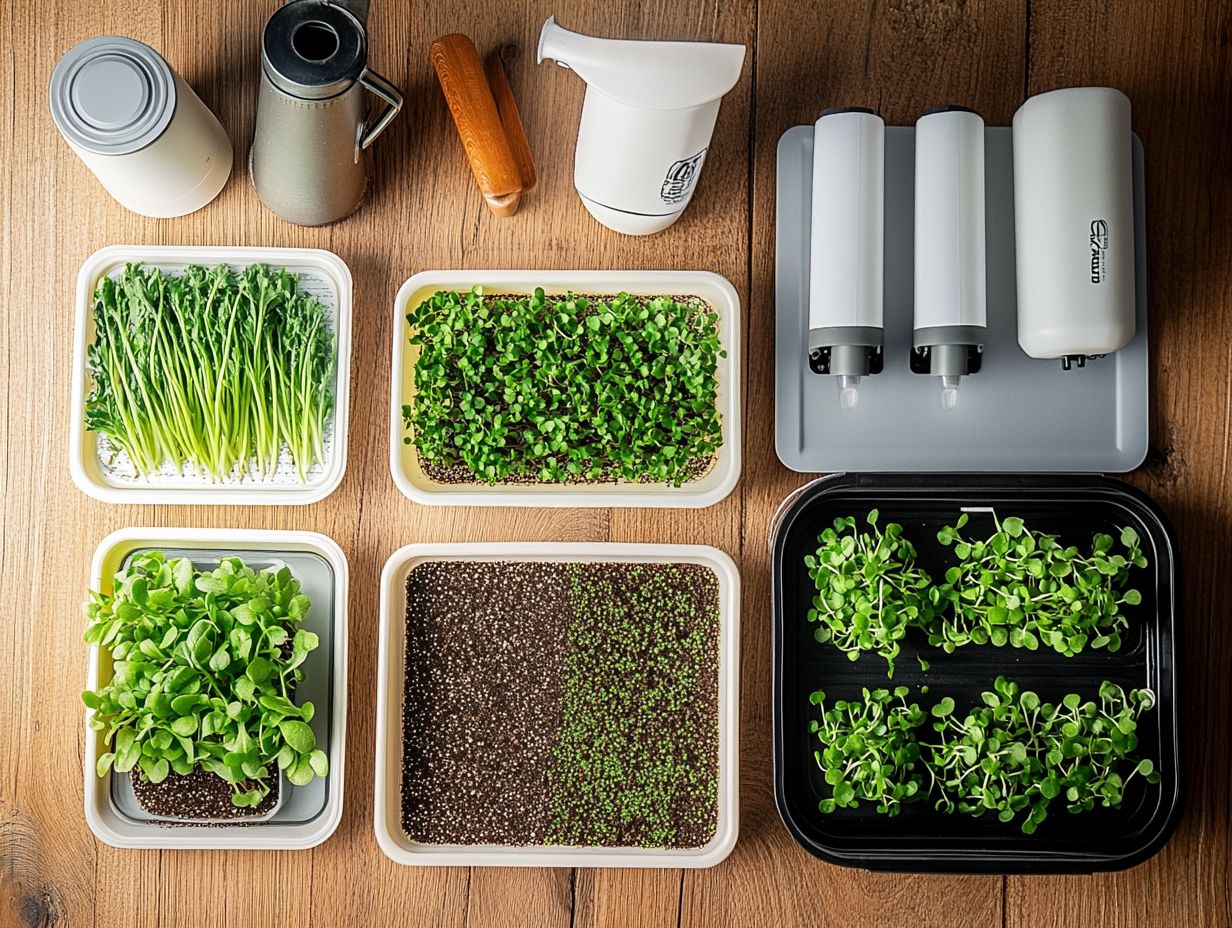
Microgreens are young vegetable greens picked when the first true leaves grow. They re packed with nutrients, easy to grow, and can add great flavor to your dishes!
What supplies do I need to grow microgreens?
You will need seeds, containers, and a light source. You might also want a spray bottle, a fan, and a heat mat for best results.
What type of seeds should I use for growing microgreens?
Seeds like spinach, kale, mustard, and sunflower work well. Be sure to use high-quality seeds made specifically for microgreens.
Can I reuse my growing supplies?
You can also reuse your trays and containers. Just clean them thoroughly to prevent bacteria or mold growth.
Do I need a special type of light for growing microgreens?
No special light is required. Any light source, including sunlight or grow lights, will work. Make sure your microgreens get 12-16 hours of light daily for the best growth!
How long does it take to grow microgreens?
The time varies by seed type and growing conditions. On average, microgreens are ready for harvest in about 1-2 weeks.

